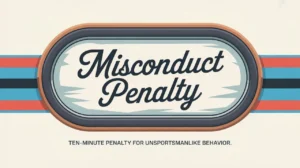Jim’s Intro to the Penalty Shot
Hi folks, Jim here, the only commentator who once thought that a penalty shot was the camera panning to you as you take a big bite out of a burger during your broadcast.
What is a penalty shot?
A penalty shot is one of hockey’s most dramatic moments. It’s awarded when a player with a clear scoring chance is illegally obstructed from behind, usually on a breakaway, or when certain defensive infractions prevent a near-certain goal (like a defender covering the puck in the crease). The referee signals by pointing to center ice, and the attacking player takes a one-on-one attempt against the goaltender. No teammates, no defenders, just shooter versus goalie.
How does it work?
Penalty shots follow a strict sequence:
- Infraction Occurs: A defending player illegally prevents a clear scoring opportunity, such as hooking a player from behind on a breakaway.
- Referee Awards Penalty Shot: The official points to center ice to signal the attempt.
- Shooter Selection: The player who was fouled usually takes the shot (unless injured), though in some leagues the coach can choose.
- One-on-One Attempt:
- The puck is placed at center ice.
- The shooter picks it up and moves toward the goalie.
- The goalie must stay in the crease until the shooter touches the puck.
- Single Attempt: The shooter gets one uninterrupted chance. There are no rebounds.
- Goal or No Goal: If the shooter scores, it counts as a regular goal. If not, play resumes with a faceoff.
The penalty shot is designed to restore the scoring chance that was unfairly taken away, making it one of the purest tests of skill and composure in the game.
Common Reasons for a Penalty Shot
- A player is fouled from behind on a clear breakaway.
- A defending player covers or closes their hand on the puck in their goal crease.
- A goalie or defender deliberately dislodges the net during a breakaway.
- A stick or object is thrown at the puck or puck carrier during a scoring chance.
- In some leagues, repeated delay tactics during shootout-like situations.
How do you make good decisions with it?
Good penalty shot decisions rely on calmness, creativity, and precision.
- For Shooters:
- Read the goalie’s positioning and speed.
- Decide early whether to deke or shoot, and commit fully.
- Don’t overhandle. Control and timing beat fancy stickwork gone wrong.
- For Goalies:
- Stay patient. The shooter has to make the first move.
- Track the puck closely and resist lunging early.
- Read the shooter’s body language to anticipate the play.
- For Teams:
- Don’t commit desperation fouls that lead to penalty shots unless absolutely necessary.
How do you master it?
Mastering penalty shots is about mental strength and practiced technique. Skilled shooters rehearse their moves until they can execute them under pressure. Goalies study tendencies, practice patience, and sharpen their reflexes for these high-stakes situations. Coaches often run penalty shot drills so players feel comfortable in the spotlight.
What does it look like when done right?
A perfectly executed penalty shot is a thing of beauty. The shooter glides in, freezes the goalie with a slick deke or quick release, and buries the puck. The crowd erupts. On the flip side, a goalie who reads the play and shuts the door can swing momentum just as dramatically. Either way, the rink falls silent in anticipation and explodes when the play ends.
Commentator’s Corner
Jim’s Take
Penalty shots are the closest thing hockey has to a spotlight monologue. One player, one goalie, no excuses.
Parent Tip
If your player ever gets a penalty shot, remind them to breathe. Confidence and a clear plan are more important than trying the flashiest move.
Player Tip
Pick two or three moves you trust and practice them relentlessly. In a penalty shot, hesitation is your biggest enemy.
A Final Thought
Penalty shots are pure hockey theatre. They reward skill, punish reckless defense, and can flip a game in a single moment. Master the pressure, and you turn a rulebook call into a highlight reel memory.









